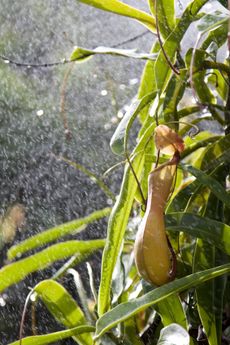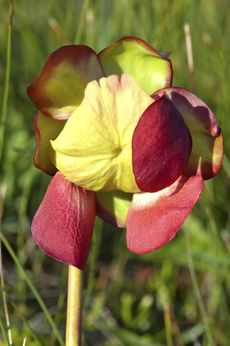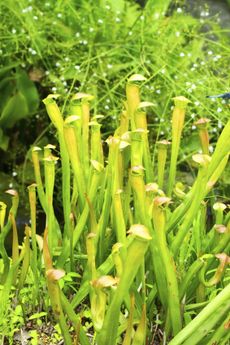Carnivorous Plant Problems: Why A Pitcher Plant Has No Pitchers


Some indoor plant enthusiasts think pitcher plants are easy to grow, while others believe the carnivorous plants are headaches waiting to happen. The truth is somewhere in the middle, and for the most part, pitcher plants are happy if you can meet their needs for water, light, and humidity. If you’re having carnivorous plant problems, such as a pitcher plant not making pitchers, it may require some troubleshooting to determine the problem. Read on for helpful tips.
My Pitcher Plant Has No Pitchers!
How to get pitchers on pitcher plants? Be patient, as pitcher plants take time to develop the first pitcher. Oftentimes, if the plant looks healthy and the tendrils are developing, a little time is all it needs. You’ll probably notice pitchers before you know it!
How to Get Pitchers on Pitcher Plants
If your plant doesn’t seem to be thriving in addition to not developing pitchers, the following tips will help with fixing pitcher plant problems:
- Light – Most pitcher plant varieties need at least three to four hours of bright sunlight per day. Failure to produce pitchers is an indication that the plant isn’t receiving adequate light. However, although the light should be bright, it should be indirect and not too intense. If the leaves are turning yellow, the plant may be getting a little too much light. Experimentation will help you determine the right amount of light for your plant.
- Water and potting mix – Pitcher plants don’t appreciate the minerals and additives in tap water. If possible, give them only filtered or distilled water. Better yet, collect rainwater and use it to water your pitcher plant. Water the pitcher plant whenever the top of the potting mix feels dry. The potting mix should never be bone dry, nor should it be soggy or waterlogged. Use a well-drained, low-nutrient potting mix such as a mix consisting of half sphagnum moss and half perlite, vermiculite, or lava rock.
- Humidity – Although requirements vary depending on the species, most types of pitcher plants prefer relatively high humidity; excessively dry air can cause the plant not to develop pitchers. Mist the plant regularly or increase the humidity in your home with a humidifier. An easy way to increase the humidity around the plant is to place the pot on a humidity tray. Just place a layer of pebbles on a tray, then set the pot on the pebbles. Add just enough water to keep the pebbles wet but be sure the pot is sitting on the pebbles but not standing in water. The plant will rot if water seeps up through the drainage hole.
- Feeding – Pitcher plants require very little supplemental fertilizer, but they do benefit from a light feeding of an acidic fertilizer. Mix 1/8 teaspoon (0.5 ml.) of acid fertilizer with 1 quart (1 L.) of water, or use a fertilizer formulated for orchids. Avoid overfeeding. Too much fertilizer can create a lush plant with no pitchers.
Gardening tips, videos, info and more delivered right to your inbox!
Sign up for the Gardening Know How newsletter today and receive a free download of our most popular eBook "How to Grow Delicious Tomatoes."

A Credentialed Garden Writer, Mary H. Dyer was with Gardening Know How in the very beginning, publishing articles as early as 2007.
-
 Urban Composting Guide: How To Compost In The Middle Of The City
Urban Composting Guide: How To Compost In The Middle Of The CityUrban composting does not have to be daunting. You can compost in the city, and maybe even try some urban worm composting!
By Mary Ellen Ellis
-
 Shrub Diseases And Pests To Watch Out For
Shrub Diseases And Pests To Watch Out ForShrub diseases and pests can be challenging. Learn how to recognize and eradicate them before they can present a danger to your plants.
By Susan Albert
-
 Black Pitcher Plant Leaves – Why Nepenthes Leaves Are Turning Black
Black Pitcher Plant Leaves – Why Nepenthes Leaves Are Turning BlackPitcher plant has specific needs, and it lets you know with alarming clarity when those needs aren't being met. This article explains what to do when you find your pitcher plant's leaves turning black. Click here to learn more.
By Jackie Carroll
-
 Watering Nepenthes – How To Water A Pitcher Plant
Watering Nepenthes – How To Water A Pitcher PlantThere are many types of exotic pitcher plants, all surprisingly easy to grow once you learn how to meet the plant's basic needs, including proper pitcher plant watering. Click here to learn what's involved in watering a pitcher plant.
By Mary H. Dyer
-
 Nepenthes Pitcher Plants: Treating A Pitcher Plant With Red Leaves
Nepenthes Pitcher Plants: Treating A Pitcher Plant With Red LeavesNepenthes pitcher plants are often grown as houseplants. If you own one, you may see your pitcher plant leaves turning red. There are various possible reasons for a pitcher plant with red leaves; some require fixing, some do not. Click here to learn more.
By Teo Spengler
-
 Pitcher Plant Pest Control: Learn About Pests Of Pitcher Plants
Pitcher Plant Pest Control: Learn About Pests Of Pitcher PlantsPitcher plants are exotic, fascinating plants, but they're prone to many of the same problems that affect any other plant, including pests. If you're wondering how to get rid of bugs on carnivorous plants, it can be tricky. Click here to find out why.
By Mary H. Dyer
-
 Do Pitcher Plants Bloom: Learn About Pitcher Plant Flowers
Do Pitcher Plants Bloom: Learn About Pitcher Plant FlowersDo pitcher plants bloom? They certainly do, and pitcher plant flowers are just as fascinating as the colorful, mysterious pitchers. Click on this article for more pitcher plant flower information. You'll be amazed at how lovely their flowers are.
By Mary H. Dyer
-
 Pitcher Plant Info: Growing Pitcher Plants In The Garden
Pitcher Plant Info: Growing Pitcher Plants In The GardenGrowing pitcher plants outdoors requires a combination of conditions quite different from ordinary garden plants. To learn what these plants need to grow outdoors, click on the article that follows for additional information.
By Karen Boness
-
 Pitcher Plant Seeds: Guide To Pitcher Plant Seed Growing
Pitcher Plant Seeds: Guide To Pitcher Plant Seed GrowingPitcher plant seed sowing is one of the best ways to reproduce this beautiful plant. But like the seeds of other carnivorous plants, they need special treatment to give them their best chance of growing. Click this article to learn more.
By Teo Spengler
-
 Trimming Pitcher Plants: Guide To Pruning A Pitcher Plant
Trimming Pitcher Plants: Guide To Pruning A Pitcher PlantGenerally, pitcher plants do not require much maintenance, but pruning a pitcher plant occasionally produces a more vigorous plant. Learn how to prune a pitcher plant and when it?s done in the following article. Click here for more info.
By Teo Spengler